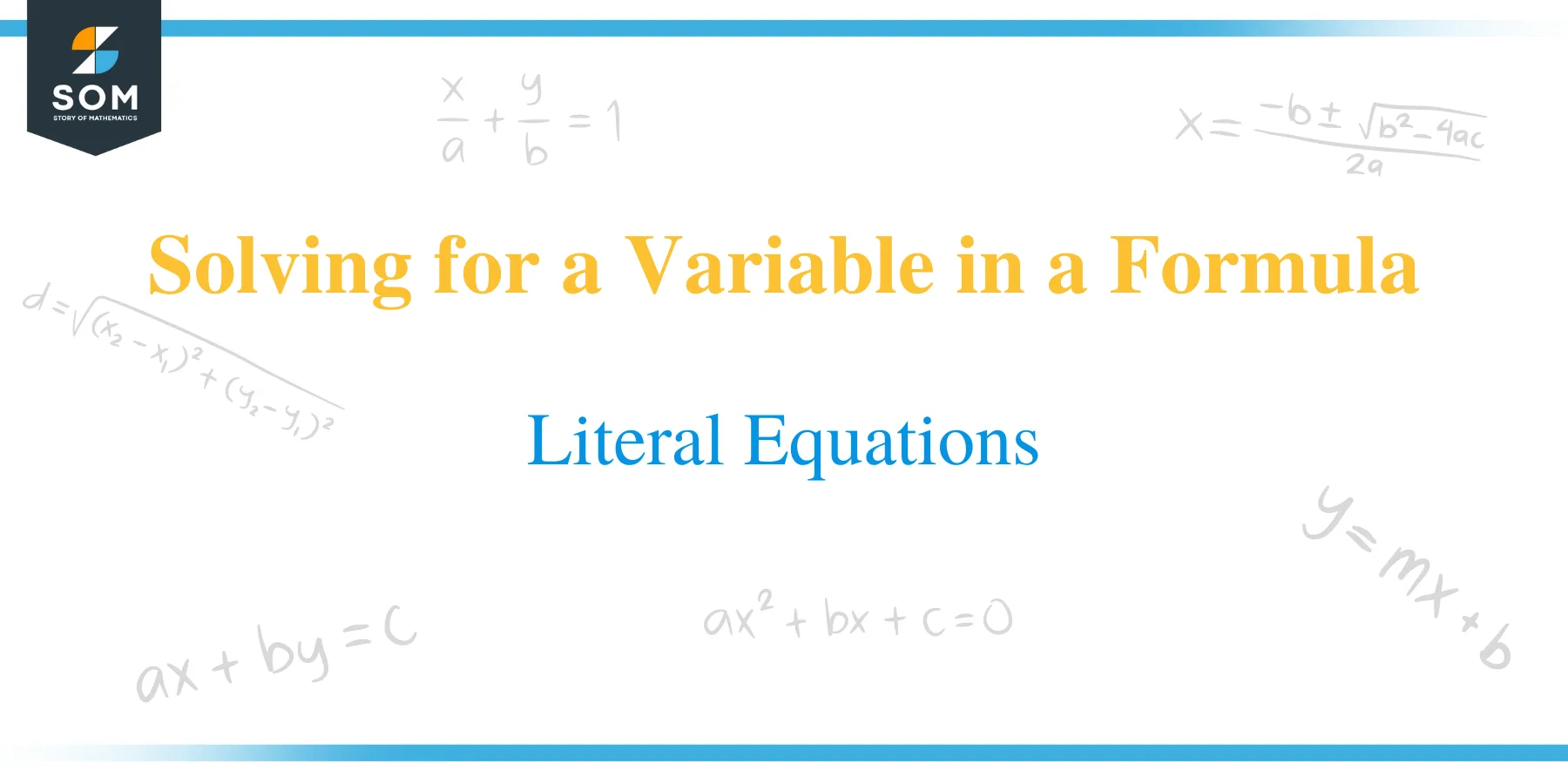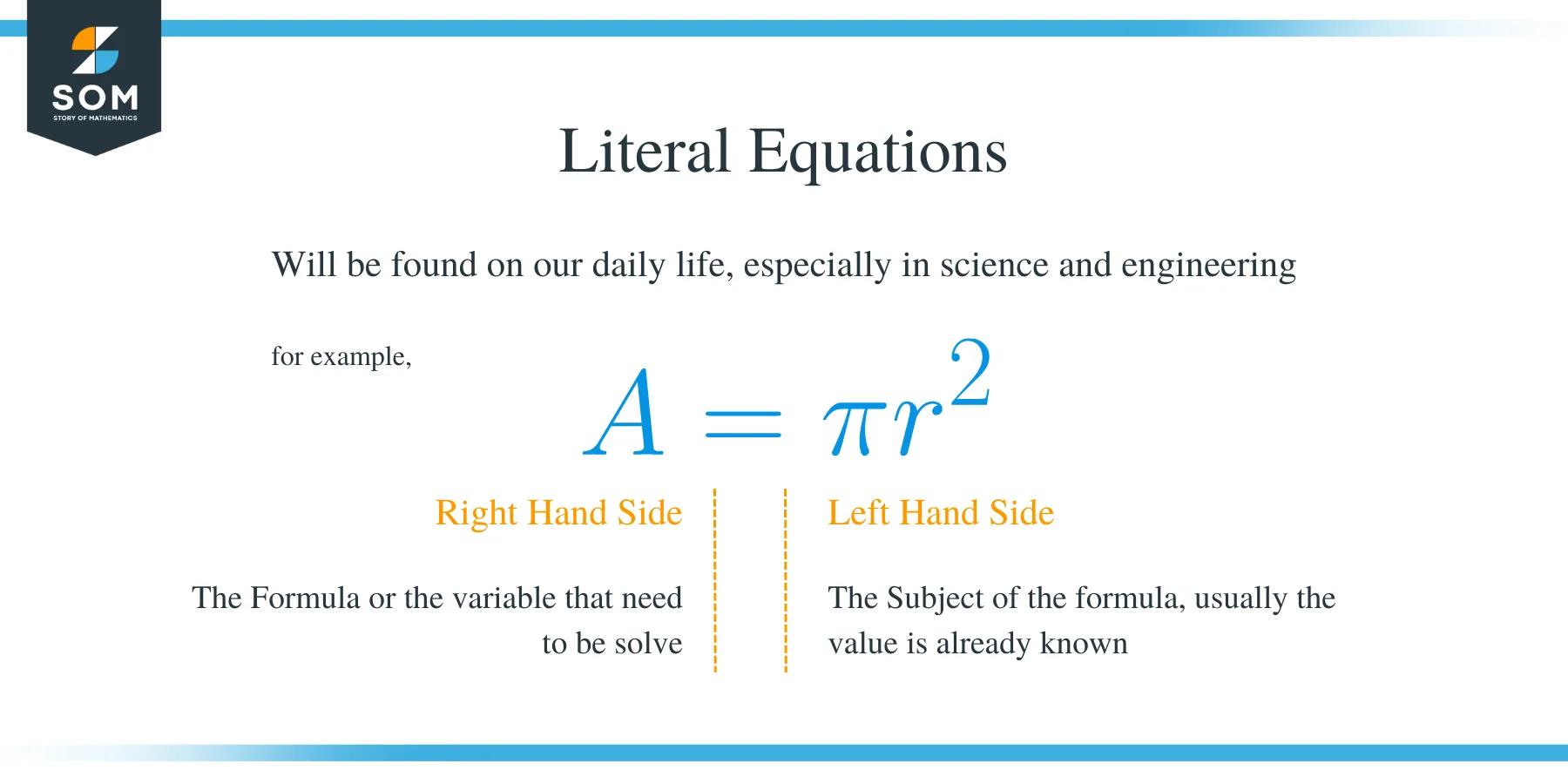- Home
- >
- Solving for a Variable in a Formula – Literal Equations
JUMP TO TOPIC
Solving for a Variable in a Formula – Literal Equations
 What are Literal Equations?
What are Literal Equations?
The use of formulas is very common in science and engineering. The formulas are manipulated to have a variable initially on the RHS, becoming the subject of the formula on the LHS. I know you have too encountered numerous formulas in your journey of studying Algebra.
Most mathematical formulas are based on geometrical concepts.
For instance, you may have come across formulas such as area of a rectangle (A = l × w), area of a circle (A = πr2), distance formula (D = v × t), etc. These kinds of formulas are known as literal equations.
The word “literal” means “related to,” and variables are sometimes called literals. Therefore, we can define literal equations as equations that contain two or more variables.
How to Solve Literal Equations?
Solving a literal equation means taking an equation with lots of variables and solving one of the variables in particular. The procedures used to solve regular One-Step Equations, Two-Step Equations, and Multi-Step Equations are also applied to solve literal equations.
The objective of solving these equations is to isolate a given variable from an equation. The only difference while solving literal equations is that process involves several letters, and simplification of the equation is limited.
This article will step by step guide you in understanding how to solve literal equations so that you can solve literal equations yourself.
Let’s look at a couple of examples below.
Example 1
Given the area of a rectangle as A = w × h, we can manipulate the variables in the equation as illustrated below:
To isolate the width(w) to the equation’s left side, A = w × h. Swap the equation and divide both sides by the height (h).
(w × h)/h = A/h
w = A/h
To isolate h on the left side, also divide both sides by w.
(w × h)/w = A/w
h = A/w
Example 2
Consider the formula for the area of a circle: A = π r2.
To isolate the radius (r) on the left side of the equation, swap the equation and divide both sides by pi (π).
(π r2) = A/ π
r2 = A/ π
To remove the exponent from r, find the positive square root of both sides of the equation.
√ r2 = √ (A/ π)
r = √ (A/ π)
Example 3
Solve for x in the literal equation 3x + y = 5x – xy.
Isolate all variables having x on the right side by subtracting 3x from both sides of the equation.
3x – 3x + y = 5x – 3x – xy
y = 2x – xy
Factorize x out in the equation
y = x (2 – y)
Now divide both sides of the equation by 2 – y
y/(2 – y) = x (2 – y)/(2 – y)
y/(2 – y) = x
That is it!
Example 4
Given the literal formula: t = a + (n – 1) d, find the value of d when
t = 10, a = 2, n = 5.
Solution
First make d the subject of the formula and substitute the values.
d = (t – a)/ (n – 1)
Now, substitute the values of t, n and a.
d = (10 – 2)/ (5 – 1)
= 8/4
= 2
Example 5
Solve for R in the following literal equation S = 3R + 5RZ.
Solution
In this case, we need to isolate variable R, and yet it is multiplied onto other terms.
The first step is to factorize R out.
S = R (3 + 5Z)
Divide both sides by (3 + 5Z).
S/ (3 + 5Z) = R (3 + 5Z)/ (3 + 5Z)
S/ (3 + 5Z) = R
Example 6
Solve T in the following equation H = (1/4) KT– (1/4) RT.
Solution
Since the expression on the right has a 4, start by multiplying through by 4 to eliminate the fractions.
4H = [ (1/4) KT– (1/4) RT]4
4H = KT– RT.
Swap the equation and factorize T out.
T (K– R) = 4H
Divide both sides by (K– R)
T (K– R)/ (K– R) = 4H / (K– R)
T= 4H / (K– R)
That is it! We have solved for T.
Example 7
Solve for y in the following formula: 2y + 4x = 2.
Solution
Subtract both sides by 4x to isolate 2y.
2y + 4x – 4x = 2 – 4x
2y = 2 – 4x
Divide by 2.
2y/2= (2 – 4x)/2
y= (2 – 4x)/2
Simplify the equation;
y= 2/2 – 4x/2
y= 1 – 2x
And that is the answer.
Example 8
Given the formula p = 2(L+ b), Calculate the value of b when P and L are 36 and 10, respectively.
Solution
The first step is to make b the subject of the formula, and then we substitute the given values of P and L.
P = 2 (L + b)
Remove the parentheses applying the distributive property of multiplication.
P = 2L + 2b
Subtracting by 2L on both sides of the equation gives;
P – 2L= 2b
Now divide both sides by 2.
(P – 2L)/2 = 2b/2
b = (P – 2L)/2
If P= 36 and L= 10, substitute the values in the equation to get b.
b = (36 – 2 × 10)/2
b = (36 – 20)/2
b = 16/2
b = 8
Example 9
The perimeter of a rectangular is given by P = 2L + 2w, where p = perimeter, L = length and w = width. Make L the subject of the formula.
Solution
We have decided to keep L on the right side by subtracting both sides by 2w.
P – 2w = 2L + 2w- 2w
P – 2w = 2L
Divide both sides of the equation by 2.
(P – 2w)/ 2 = 2L/2
P/2 -w = L
Yep! We are done.
Example 10
Find for t in the following literal equation v = u + at.
Solution
Subtract u from both sides.
v – u = u – at – u
v – u = at
On dividing both sides by a we obtain;
(v – u)/a = at/a
t = (v – u)/a
How to solve literal equations with fractions?
Let’s understand this concept with the help of a few examples below:
Example 11
Make y the subject of the formula in the following literal equation x = (y + z)/ (y – z)
Solution
Multiply both sides by (y – z)
x = (y + z)/ (y – z)
x (y – z) = y + z
xy – xz = y + z
xy – y = z + zx
y (x – 1) = z (x + 1)
y = z (x + 1)/ (x – 1)
Example 12
Solve A in the literal equation below:
B/5 = (A – 32)/9
Solution
B/5 = (A – 32)/9
⇒ 9B/5 = A – 32
⇒ 9B/5 + 32 = A
⇒ A = 9B/5 + 32
Example 13
Given a literal formula A = P {1 + (r/100)} ⁿ. Find r when A = 1102.50, P = 1000 and n is given as 2.
Solution
A = P {1 + (r/100)} ⁿ
Divide both sides of the equation by P.
A/P = {1 + (r/100)} ⁿ
Calculate the nth root on both sides of the equation.
(A/P)1/n = {1 + (r/100)}
Subtract both sides by 1.
(A/P)1/n – 1 = r/100
Multiply both sides by 100 to eliminate the fraction.
100 {(A/P)1/n – 1} = r
To find the numerical value of r, substitute p the values of P, n and A in the equation.
r = 100 {(1102.50/1000)1/2 – 1}
= 100 {(110250/1000)1/2 – 1}
= 100 {(441/400)1/2 – 1}
= 100 [{(21/20)2}1/2 – 1]
= 100 {(21/20)2 x 1/2 – 1}
= 100 {21/20 – 1}
= 100 {(21 – 20)/20}
= 100 × 1/20
= 5
Example 14
Make d the subject of the formula Q = (c + d)/2
Solution
Cross multiply the equation and eliminate the brackets:
Q= (c + d)/2 => 2Q = c + d
To isolate d subtract both sides by c
2Q – c = c- c + d
2Q – c = d
d = 2Q – c. And we’re done!
Example 15
Solve for x in the following literal equation
(x -2)/ (3y – 5) = x/3
Solution
This kind of equation is having rational expression on both sides, therefore we perform cross multiplication;
(x -2)/ (3y – 5) = x/3 => 3(x-2) = x (3y – 5)
Apply the distributive property of multiplication to remove the brackets;
3x – 6 = 3xy – 5x
Let’s keep x’s on the left side.
Eliminate -5x on the right by adding 5x to both sides
3x + 5x – 6 = 3xy – 5x + 5x
8x -6 = 3xy
To keep all x’s on the left, subtract both sides by 3xy.
8x -3xy -6 = 3xy -3xy
8x – 3xy – 6 = 0
Now transfer the constant on the right side by adding both sides by 6.
8x – 3xy – 6 + 6= 0 + 6
8x – 3xy = 6
Factorize out x.
x (8x – 3y) = 6
Divide both sides by 8x-3y
x (8x – 3y)/ (8x – 3y) = 6/ (8x – 3y)
x=6/ (8x – 3y)
And that is the answer!
